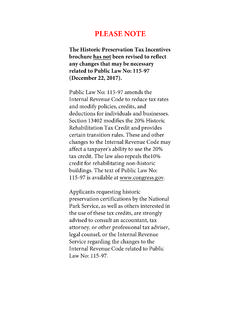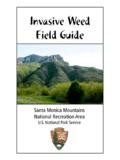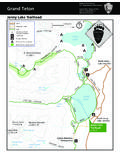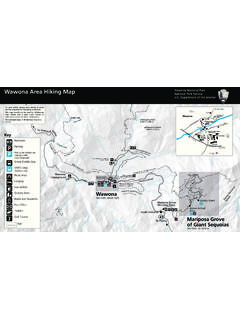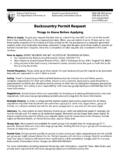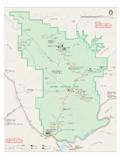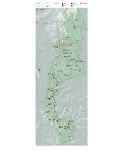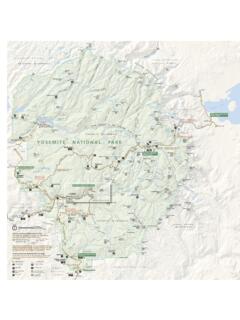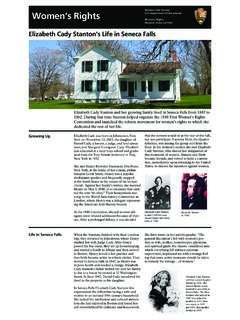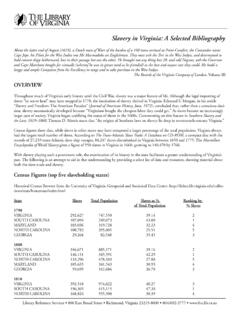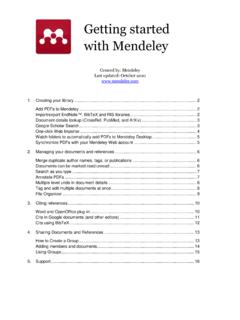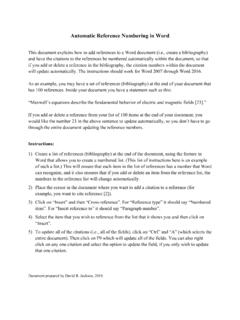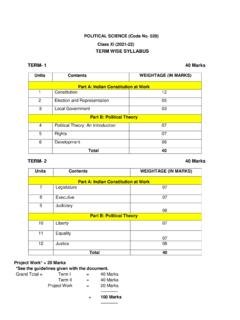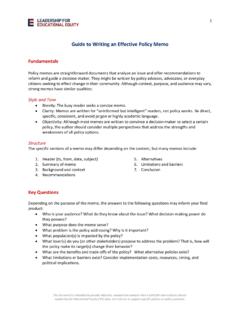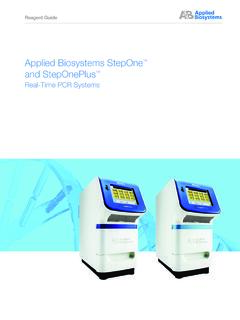Transcription of Chapter 6: Handling, Packing, and Shipping
1 Chapter 6: handling , packing , and Shipping A. Introduction .. 6:1. B. handling 6:2. Why are careful handling practices important?.. 6:2. Who needs to learn safe handling practices?.. 6:2. What basic practices can I use to safely handle and move objects in the museum? .. 6:2. How should I proceed with moving an object? .. 6:3. What are the basic rules for handling museum objects?.. 6:4. What is the best way to protect an object I must pick up? .. 6:6. When should I wear gloves?.. 6:6. What should I do if I damage an object? .. 6:6. What personal health and safety issues should I consider when handling museum objects? .. 6:7. C. Moving Objects Within the 6:9. What should I do before moving objects within the museum? .. 6:9. What do I need to know before moving objects? .. 6:9. D. packing and Shipping Preparations .. 6:11. When would I need to pack and ship objects?
2 6:11. Why is it important to properly pack objects for Shipping ? .. 6:11. How can I learn how to pack museum objects?.. 6:11. What kind of workspace do I need for packing ? .. 6:11. How much time should I allow for packing objects?.. 6:12. What do I need to consider before Shipping ? .. 6:12. How do I determine if the object can be safely shipped? .. 6:12. How do I ship hazardous materials? .. 6:13. How should I document the condition of the objects?.. 6:13. E. packing and Shipping Materials .. 6:13. Why is it important to use the right packing and Shipping materials? .. 6:13. What sources of packing materials are available?.. 6:13. What are good covering and wrapping materials?.. 6:14. What are good cushioning materials? .. 6:15. What materials make good interior boxes? .. 6:15. What kind of tape should I use on the box and the wrapping material?
3 6:16. How should I select an exterior container?.. 6:16. What kinds of containers do I use for objects that have different weights and sizes? .. 6:17. Can I build an exterior container? .. 6:17. Can I use a reusable Shipping container? .. 6:17. How do I protect objects from environmental changes during Shipping ?.. 6:17. How should I store packing materials?.. 6:17. F. packing for Shipping .. 6:18. How do I decide which way to position an object in a container?.. 6:18. How do I cover and wrap an object?.. 6:18. How should I cushion the object inside the container? .. 6:19. What other techniques can I use to cushion objects and provide shock absorption?.. 6:20. What should I do before closing the container?.. 6:22. Should I wrap and label the Shipping container? .. 6:22. What should I put on the label on the exterior of the container? .. 6:22.
4 What kind of identification markings should I put on the box?.. 6:23. G. Shipping 6:23. What things should I consider if I use a professional packer/shipper? .. 6:23. What transportation alternatives are available for Shipping museum objects?.. 6:24. When should I use the Postal Service?.. 6:24. When should I use commercial package delivery services? .. 6:24. When should I use an art shuttle van or special product truck? .. 6:25. When should I use airfreight? .. 6:25. Should I use a courier?.. 6:25. H. Receiving and Unpacking the 6:26. How should I unpack a container? .. 6:26. Should I check for insect infestation?.. 6:27. What do I do if an object is damaged, lost, or destroyed during Shipping ?.. 6:27. I. Selected bibliography .. 6:28. List of Figures Figure Proper handling Techniques.. 6:1. Figure Carts and Trays Minimize 6:2. Figure Equipment and Supplies.
5 6:3. Figure Hold Objects at the Strongest 6:5. Figure Wear Gloves and Use Both Hands.. 6:6. Figure How to Lift Properly and Avoid 6:7. Figure The Proper Way to Lift a 6:8. Figure The Proper Way to Lift a Small, Framed 6:8. Figure The Proper Way to Lift and Carry a Small Textile Object .. 6:8. Figure Use Trays and Padding to Prevent 6:10. Figure Pad and Separate 6:19. Figure Wrapping, Padding, and packing for Shipping an Object .. 6:20. Figure Objects Double-boxed for Shipping .. 6:21. Figure Example of Written handling Rules for NPS Park Collections.. 6:30. Chapter 6: handling , packing , AND Shipping . A. Introduction This Chapter outlines handling , packing , and Shipping guidelines for safely moving museum objects. By following these guidelines, you can prevent damage to the objects in your museum collection. The Chapter includes: basic practices to ensure object safety guidelines for handling objects guidelines for moving objects inside the museum materials and techniques to properly pack for Shipping basic directions for Shipping objects guidelines for unpacking an object bibliography of references on handling , packing , and Shipping museum objects Specific guidance for handling different types of objects can be found in the appendices of this volume for each object type.
6 Figure Proper handling Techniques. Proper handling techniques are essential to museum housekeeping practices. NPS Museum Handbook, Part I (1999) 6:1. B. handling Objects When you touch, lift, or hold an object you are handling it. When you work in a museum you will have to handle objects for a variety of tasks. To do this safely and effectively it is important to learn and practice good handling techniques. 1. Why are careful handling Preventive conservation starts with careful handling . Proper handling is practices important? largely a matter of common sense and is necessary for the care and protection of objects. However, good handling techniques are not always obvious. Museum procedures require specialized handling knowledge that must be learned. For example, metals can corrode after being handled without gloves. Paintings may crack as a result of bumping and jarring during movement.
7 Mishandling can cause obvious examples of damage, such as shattered glass in a frame, broken ceramics, torn documents, or dents and scratches in metal objects. Figure Carts and Trays Minimize handling . The use of equipment and supplies such as carts and trays minimizes the need to handle objects. 2. Who needs to learn safe Anyone who handles museum objects needs to be aware of the guidelines handling practices? in this Chapter . If your day-to-day responsibilities require you to handle objects, you need to be sensitive to their delicate nature. Regular activities like cataloging, photographing, housekeeping, and packing for shipment all require you to handle and work with objects. 3. What basic practices can I Write guidelines. use to safely handle and Establish written guidelines to help foster a professional attitude and move objects in the respect for objects.
8 Provide all staff with a set of written guidelines. Post museum? the guidelines in museum storage areas. Be sure that all staff who handle objects read the guidelines. Researchers who handle objects should read the guidelines when they first use the collections. Staff should read the guidelines when hired and review them periodically. See Figure for an example of handling guidelines you can use. 6:2 NPS Museum Handbook Train your staff. Don't handle museum objects without training. Training should be an on-going activity, particularly when new types of objects are being handled. Make hands-on experience a part of all training for individuals working with collections. Re-training reminds people of the importance of proper handling techniques. You should give a special training session whenever new staff members assist in handling objects. Use proper supplies and equipment.
9 Only use equipment that is of good quality and in good condition. Equipment for moving objects includes flatbeds, carts, dollies, pallet lifters, polyethylene tote pans, and object support trays. The supplies you use with the equipment to move objects include polyethylene foam pads for lining carts and trays, quilted furniture pads, acid-free tissue, and clean cotton or plastic gloves. You may need to acquire personal protective equipment such as lab coats and smocks, safety glasses, dust masks, and personally fitted respirators. Supplies and equipment are listed in more detail below. Figure Equipment and Supplies. Equipment and supplies for handling and moving museum objects include trays, padding, tissue, gloves, and carts. 4. How should I proceed with Consider safety first. moving an object? Before moving an object, inspect equipment to ensure that the object and the handler will be safe during the move.
10 Do you have the proper personal protective equipment? Identify the space where you will move the object. Make sure there is room to house the object in its new location. If you have inadequate equipment, supplies, or space, postpone moving the object. Plan your move. Never consider moving an object routine work, even for daily housekeeping tasks. You must plan each step in the process before handling or moving a museum object. Where will you stand before picking up the object? Is there an open space to receive it? Planning helps keep handling to a minimum. When you plan, it helps you remember that each museum object is special. Keep in mind the following factors when you plan to move an object: Do you need to move the object? Is moving the object absolutely necessary? If not, don't move it. NPS Museum Handbook, Part I (1999) 6:3. What are the object's structural characteristics and condition?
